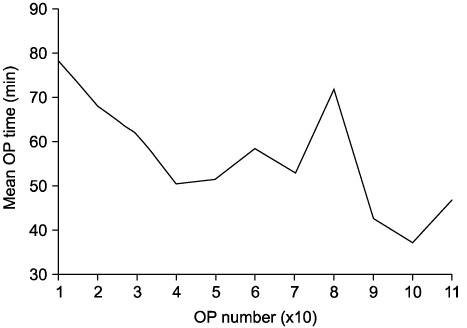J Korean Surg Soc.
2009 Oct;77(4):273-278. 10.4174/jkss.2009.77.4.273.
The Comparative Analysis between Laparoscopic Total Extraperitoneal Repair and Open Tissue Repair: Initial Experience of a Single Institute
- Affiliations
-
- 1Department of Surgery, St. Vincent's Hospital, The Catholic University of Korea, Suwon, Korea. dkkwkh@catholic.ac.kr
- 2Department of Surgery, College of Medicine, Seoul St. Mary's Hospital, Seoul, Korea.
- KMID: 1464886
- DOI: http://doi.org/10.4174/jkss.2009.77.4.273
Abstract
- PURPOSE
Laparoscopic herniorrhaphy has been recognized as one of the treatment options for inguinal hernia. This study compared the short-term results of two methods of repair: totally extraperitoneal (TEP) repair and open tissue based repair. METHODS: A retrospective review was conducted on all patients who underwent laparoscopic TEP repair (LH, 105 cases) and open repair (OH, 57 cases) at our hospital between September 2007 and December 2008. Posterior wall repairs in open technique follow as McVay (25 cases) and Bassini (32 cases). Demographic data, operation time, perioperative complications, consumption of analgesics, and hospital stay were compared. RESULTS: There was no significant difference in relation to patient characteristics; age, gender, BMI, medical and surgical history and hernia type. Also, there was no difference of operation time for both groups. Patients in the LH group consumed fewer analgesics (P=0.002). Intraoperative complications occurred more frequently in the LH group (P=0.036) but postoperative complications were similar. Hospital stay was shorter in LH (P<0.001). There was no difference of recurrence between LH group and OH group for 16 months. CONCLUSION: Laparoscopic TEP repair shows similar postoperative complications and recurrences and with less postoperative pain and hospital stay, compared with open tissue based hernia repair. However, further study with longer follow up data is necessary.
MeSH Terms
Figure
Reference
-
1. Bassini E. Nuovo metodo per la cura radicale hernia inguinale. Atti Conger Assoc Med. 1887. 2:179.2. Kim YH, Shin JH, Park JJ, Sohn BH, Yoo CH, Park YR, et al. A clinical review of the advantages of laparoscopic inguinal herniorrhaphy. J Korean Surg Soc. 2001. 61:604–608.3. Lichtenstein IL, Shulman AG, Amid PK, Montllor MM. The tension-free hernioplasty. Am J Surg. 1989. 157:188–193.4. Fitzgibbons RJ Jr, Puri V. Laparoscopic inguinal hernia repair. Am Surg. 2006. 72:197–206.5. Sanjay P, Woodward A. A survey of inguinal hernia repair in Wales with special emphasis on laparoscopic repair. Hernia. 2007. 11:403–407.6. Kingsnorth A, LeBlanc K. Hernias: inguinal and incisional. Lancet. 2003. 362:1561–1571.7. Bay-Nielsen M, Kehlet H, Strand L, Malmstrom J, Andersen FH, Wara P, et al. Quality assessment of 26,304 herniorrhaphies in Denmark: a prospective nationwide study. Lancet. 2001. 358:1124–1128.8. Gould J. Laparoscopic versus open inguinal hernia repair. Surg Clin North Am. 2008. 88:1073–1081.9. Ger R. The management of certain abdominal herniae by intra-abdominal closure of the neck of the sac. Preliminary communication. Ann R Coll Surg Engl. 1982. 64:342–344.10. Ger R, Monroe K, Duvivier R, Mishrick A. Management of indirect inguinal hernias by laparoscopic closure of the neck of the sac. Am J Surg. 1990. 159:370–373.11. Fitzgibbons RJ Jr, Camps J, Cornet DA, Nguyen NX, Litke BS, Annibali R, et al. Laparoscopic inguinal herniorrhaphy. Results of a multicenter trial. Ann Surg. 1995. 221:3–13.12. Vogt DM, Curet MJ, Pitcher DE, Martin DT, Zucker KA. Preliminary results of a prospective randomized trial of laparoscopic onlay versus conventional inguinal herniorrhaphy. Am J Surg. 1995. 169:84–89.13. Leibl BJ, Schmedt CG, Ulrich M, Kraft K, Bittner R. Laparoscopic hernia repair -- the facts, but no fashion. Langenbecks Arch Surg. 1999. 384:302–311.14. Ger R, Mishrick A, Hurwitz J, Romero C, Oddsen R. Management of groin hernias by laparoscopy. World J Surg. 1993. 17:46–50.15. Youn SI, Kim BG, Cha SJ, Chang IT. The comparative analysis between laparoscopic inguinal herniorrhaphy and open inguinal herniorrhaphy. J Korean Surg Soc. 2005. 69:166–171.16. Kuhry E, van Veen RN, Langeveld HR, Steyerberg EW, Jeekel J, Bonjer HJ. Open or endoscopic total extraperitoneal inguinal hernia repair? A systematic review. Surg Endosc. 2007. 21:161–166.17. Bowne WB, Morgenthal CB, Castro AE, Shah P, Ferzli GS. The role of endoscopic extraperitoneal herniorrhaphy: where do we stand in 2005? Surg Endosc. 2007. 21:707–712.18. EU Hernia Trialists Collaboration. Laparoscopic compared with open methods of groin hernia repair: systematic review of randomized controlled trials. Br J Surg. 2000. 87:860–867.19. Kim JS, Jang HJ, Cho YP, Kim YH, Choi YB, Han MS. A comparing study of herniorrhaphies laparoscopy, lichtenstein and conventional repairs. J Korean Surg Soc. 2002. 63:57–62.20. Wellwood J, Sculpher MJ, Stoker D, Nicholls GJ, Geddes C, Whitehead A, et al. Randomised controlled trial of laparoscopic versus open mesh repair for inguinal hernia: outcome and cost. BMJ. 1998. 317:103–110.21. Stoker DL, Spiegelhalter DJ, Singh R, Wellwood JM. Laparoscopic versus open inguinal hernia repair: randomised prospective trial. Lancet. 1994. 343:1243–1245.22. Papachristou EA, Mitselou MF, Finokaliotis ND. Surgical outcome and hospital cost analyses of laparoscopic and open tension-free hernia repair. Hernia. 2002. 6:68–72.23. Corbitt JD Jr. Transabdominal preperitoneal herniorrhaphy. Surg Laparosc Endosc. 1993. 3:328–332.24. Lowham AS, Filipi CJ, Fitzgibbons RJ Jr, Stoppa R, Wantz GE, Felix EL, et al. Mechanisms of hernia recurrence after preperitoneal mesh repair. Traditional and laparoscopic. Ann Surg. 1997. 225:422–431.25. Neumayer L, Giobbie-Hurder A, Jonasson O, Fitzgibbons R Jr, Dunlop D, Gibbs J, et al. Open mesh versus laparoscopic mesh repair of inguinal hernia. N Engl J Med. 2004. 350:1819–1827.
- Full Text Links
- Actions
-
Cited
- CITED
-
- Close
- Share
- Similar articles
-
- Totally Extraperitoneal Laparoscopic Repair of Obturator Hernia withPartial Intestinal Obstruction
- Laparoscopic total extraperitoneal repair of lumbar hernia
- Prevention and management of intraoperative complication during single incision laparoscopic totally extraperitoneal repair
- Laparoscopic transabdominal extraperitoneal mesh repair of lumbar hernia
- The Comparative Analysis between Laparoscopic Inguinal Herniorrhaphy and Open Inguinal Herniorrhaphy


